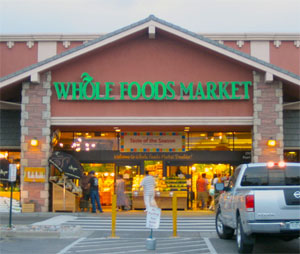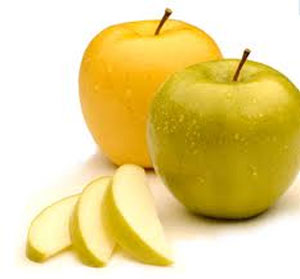Food files – from goodbye KFC to no-brown apples?
A week and a half ago, on the tail end of Canada Day weekend here, I foolishly ate something that really should have been thrown away. As food poisoning goes, what followed was tolerable. Just a few days of death to all digestive capacity. Followed by a surreal state of absolutely no interest in eating whatsoever. (Food? What’s that? Why would I want any? Pass.)
With health restored, this week I am all about food, glorious food!
So here are some food stories that caught my eye. First, one from the New York Times on the peculiarities of the organic label in the US food system: “Has “Organic’ been oversized?”

Whole Foods Markets cast 1 of 6 votes to certify the herbicide ammonium nonanoate for inclusion in organic foods under the USDA Organic Label. The measured failed by 2 votes. Photo: chickenscrawl via Flickr, some rights reserved
According to the article, the “USDA Organic” label, supervised by the National Organics Standards Board, can include non-organic ingredients, if approved by panel vote.
As corporate membership on the board has increased, so, too, has the number of nonorganic materials approved for organic foods on what is called the National List. At first, the list was largely made up of things like baking soda, which is nonorganic but essential to making things like organic bread. Today, more than 250 nonorganic substances are on the list, up from 77 in 2002.
The board has 15 members, and a two-thirds majority is required to add a substance to the list. More and more, votes on adding substances break down along corporate-independent lines, with one swing vote. Six board members, for instance, voted in favor of adding ammonium nonanoate, a herbicide, to the accepted organic list in December. Those votes came from General Mills, Campbell’s Soup, Organic Valley, Whole Foods Market and Earthbound Farms, which had two votes at the time.
Big Organic lost that round. Had it prevailed, it would have been the first time a herbicide was put on the list.
Is this approval method appropriate, or compromised? What’s in a label anyway, and what conflicts emerge as organic gets embraced by the corporate structure? It’s a worthwhile read.
Next, a woman whose family has been closely tied to KFC for over 50 years has decided she needs to head in a different direction. As reported in the National Post:
Renee Marquis had a dream, a vision really, to open a chain of family restaurants.
To give customers healthy, tasty, home-cooked fare — with lots of fruits and vegetables — and packed with down-home Newfoundland goodness and everything else she wasn’t offering in her day job as the owner of 10 KFC (aka Kentucky Fried Chicken) restaurants scattered around the province.
Marquis’s parents brought the first KFC to Newfoundland way back in 1960. She respects the company and thinks it has good standards – for the fast food industry. She’s just not able to get excited about fast food anymore.
“For me, as a foodie, I wanted to stretch my wings a little bit,” Ms. Marquis says.
“We have beautiful wild produce in Newfoundland, we’re surrounded by the ocean. I want to give people a fresh option, not just haul something out of a freezer or open up a tin and charge premium price for junk food.
“Newfoundland women bottle rabbit stew. And it’s delicious, and in France they’d be calling it lapin, but here we’d say go check the snare line and this is what we are having for dinner. We are valid in the food world, let me tell you, Newfoundland women, oh my god, how they can cook.”
The rise of fast food does fan a nostalgic longing for “home cooking” or “real food”, whatever that means. (And let’s not forget NCPR’s own useful list and map of good eats in this region, found here.)
But will fresh/local/unique sell? When you travel, do you seek the tried and true safety of food that’s identical cost to coast? Or chance the truly different?
The National Post article wondered if a famed Newfoundland classic would be on the menu: fish and brewis (pronounced “brews”). I had to go look that one up. It doesn’t sound overly appealing, at least as described by Wikipedia:
The typical recipe calls for salt fish that is soaked in water overnight to reduce the salt content of the fish. The hard bread is broken into bite-size pieces, and it too is soaked in water overnight. The next day, the fish and hard bread are boiled separately until tender, and then both are served together.
An actual recipe looks somewhat more palatable. A CBC interview with Marquis indicates she hopes to be licensed to serve game, including moose. And she’s sure the menu will include her Mom’s recipe for Tennessee BBQ ribs. Should be interesting!

The Arctic Apple: slices stay white. Four troublesome genes that cause browning were “silenced.” 69% of people surveyed said no thanks to the GM fruit. Photo: arcticapples.com
Lastly, also in the New York Times, there is the arrival of a genetically modified apple that doesn’t turn brown after being cut. This new “Arctic Apple” was developed in Canada, no less! Here is the company website for Okanagan Specialty Fruits, in B.C. As the NYT article puts it:
Neal Carter, the founder and president of the company, which is based in the Okanagan Valley of British Columbia, said the nonbrowning apples could improve industry sales, much as baby carrots did for carrot sales.
A whole apple is “for many people too big a commitment,” he said. “If you had a bowl of apples at a meeting, people wouldn’t take an apple out of the bowl. But if you had a plate of apple slices, everyone would take a slice.”
This is another fascinating topic. Since humans have been tinkering with different breeds of plants and animals for thousands of years, this seems to hinge squarely on squeamishness over the new kid on the block: genetic engineering.
The USDA is opening a 30-day comment period on the company’s application for approval of the GM trees (You can find .pdf info on that at the USDA site.) The public comment period in Canada with the Canadian Food Inspection Agency closed earlier this month. (And there’s a lot of useful info on that webpage, if you want more details.)
Conventional apple growers have come out against approval, citing concerns that approval of GM apples could tarnish the apple’s image as a healthy, natural food. At least one survey indicates public rejections as well. According to the EpochTimes:
Of the 1,501 people surveyed, 69 percent said they are against approval of the apple, which is genetically engineered to not turn brown when cut.
Seventy six percent feel that the federal government has not provided enough information about genetically modified foods, while 91 percent are in favour of government regulations that would make the labelling of GM food products mandatory.
By the way, we all know that you can keep apples looking fresh using a dip of lemon juice. But how many people bother to do that? The comment section of the NYT article carries the debate further: is a no-brown apple just another way to serve stale food that’s past its prime? Or are all avenues that encourage more consumption of unprocessed foods worth pursuing?
Food! Gotta love it!
But… when in doubt – especially in this heat – throw it out!
Tags: agriculture, Arctic Apples, food, genetically modified food, Okanagan Specialty Fruits, organic food, regional cooking, Renee Marquis








I read a book years ago…something about the French intensive bio-dynamic gardening method. One of the points that has stuck with me is that you should never feel bad about putting something into the compost. It’s like a bank account, and will all return to you the next season. Nobody wants wilted produce, but the worms in your compost will be glad to take it off your hands.
When in doubt, feed the worms.
I wish we could return to the days when fruits and vegetables were perishable and only available in season. Then, at least, they had some taste. Is it just me, or is the taste missing from much of the food that is commercially available today?
Thats why , Larry, I eat local food when available and I just don’t buy store bought strawberries, apples etc. if they are sold. You notice, with local food, the aroma of the food, even berries, is strong. In the grocery store nothing tastes right. Even garden potatoes taste different, much better than store bought. Swiss chard, compete different animal from the garden, vs. the store. So…from say April until October I eat vegetable stand food and my own grown food. I can. The rest of the year I eat fish, and sometimes occasionally meat, and a lot of pasta with my home canned tomatoes. If you like flavor…it can be done. Oh, and I totally and have forever boycotted Walmart, and that goes for their “food’ too,